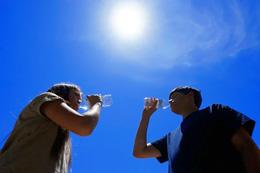Heatwave in Asia creates ‘cocktail of hazards’

Governments across the region have issued urgent health warnings, advising citizens to take precautions against the dangerously high temperatures.
The summer heat has arrived early, setting records and even claiming lives, and it's expected to get much worse through May and June as summer actually begins.
Scientists warn of wide-ranging impacts in some of the world's most densely populated regions, and they're urging governments to take immediate action to prepare for the impact of climate change and do whatever is possible to mitigate human-caused global warming.
Around the world, countries have tried to manage the impact of extreme weather events through early warning systems and advisories, but Asia's large, poor populations will bear the brunt of the impact of the heat wave, said experts.
The heat is likely to continue inflicting widespread crop damage, further impacting the lives of farmers who've already faced increasing challenges in recent years — to the extent that hundreds of thousands staged massive protests in India to demand government help.
A UNICEF statement said that in the Asia-Pacific region, “around 243 million children are exposed to hotter and longer heatwaves, putting them at risk of a multitude of heat-related illnesses, and even death.”
This year, Cambodia has been facing the highest temperatures in 170 years and the forecast is that temperatures in most parts of the country could reach up to 43C (109F) this week.
Myanmar’s Meteorological Department said seven townships in central Magway, Mandalay, Sagaing and Bago divisions experienced unprecedented high temperatures.
In northern Thailand, temperatures have topped 44C (111F) in some areas, while the capital, Bangkok, and the metropolitan areas have witnessed temperatures above 40C (104F). The forecast from the Meteorological Department said this year’s summer, which usually lasts from late February to late May, is expected to be 1-2C (1.8-3.6F) hotter than last year’s, and rainfall will be lower than average.
Thailand’s Department of Disease Control said last week at least 30 people have died from heatstroke so far this year, compared with 37 for all of last year.
Vietnam’s national weather agency warned of the risks of forest fires, dehydration, and heat shock, while the state electricity company urged consumers to refrain from overworking their air-conditioning units, warning that electricity consumption has reached record highs in recent days.
Parts of India experienced a heatwave for up to 26 days in April, resulting in over nine deaths across the country. The eastern Indian states of West Bengal and Odisha recorded the hottest temperatures in the past decade, with some states experiencing temperatures seven or eight degrees above the normal average. The southwestern coastal state of Kerala also experienced a rare heatwave, resulting in two fatalities.
Extreme heat also troubled voters in certain Indian states during the ongoing general elections
In late April, the Southern region of Nepal experienced temperatures higher than usual, reaching above 40 degrees Celsius in some areas. This has led to an extended period of intense heat and dry weather conditions, sparking wildfires across the country.
Countries are preparing for more extreme weather in coming months.
Japan, where people sweltered during its hottest summer on record last year, began operating a heatstroke alert system last week. Starting this year, a second type of warning has been added for when prefectures are expected to be hit by particularly high temperatures that pose serious risks to human health. The aim is to more strongly urge local governments and citizens to take protective measures like utilizing publicly designated "cooling shelters" or air-conditioned facilities.
Singapore, which relies heavily on migrant construction workers, has told employers to monitor the wet-bulb globe temperature, an internationally recognized heat measurement, and provide laborers performing heavy physical activity with a minimum 10-minute break every hour when the reading hits 32 C or higher. The rules started in October last year and aim to protect outdoor workers from the risks of heat stress.
High temperatures are also putting pressure on electricity supplies. Heatwaves have led to increased demand for cooling options like air conditioning across the region. This increased demand for energy has left electricity grids struggling to cope.
Thailand saw overall power usage surge to repeated record highs last week as temperatures soared. In Vietnam and the Philippines, increased demand has threatened to overload electricity grids.
The World Meteorological Organisation’s (WMO) most recent report revealed that Asia is warming faster than the global average. The warming trend has nearly doubled since the 1961 to 1990 period.
The continent was also the most disaster-hit region in the world last year. In 2023, flood and storm events alone caused more than 2,000 fatalities with more than 9 million people directly affected.
The WMO also noted that, despite growing risks posed by high temperatures, heat-related deaths are often not reported.
The changing climate is creating "significant additional health hazards for workers" such as cancer, respiratory illnesses, kidney disfunction and mental health conditions, according to the International Labour Organization.
Thousands of work-related deaths are linked to a "cocktail of hazards" including excessive heat, skin cancer caused by solar ultraviolet radiation, air pollution, pesticide poisoning and parasitic and vector-borne diseases, the U.N. agency said in a report.
After 2023 became the world's hottest year on record and Asia faced "phenomenal" levels of heat waves and humidity, "I'd expect to see similarly intense heat waves to last year ... and also typhoons," said Sarah Perkins-Kirkpatrick, professor of climate science at Australian National University (ANU).
- Agencies









